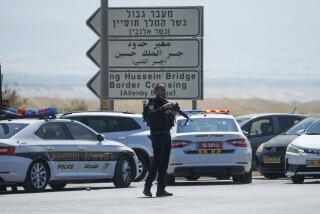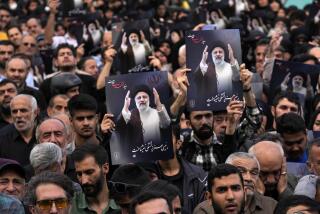Iraq Blames Iran for Fatal Jet Hijacking
- Share via
AMMAN, Jordan — Iraq accused Iran on Friday of being behind the Christmas Day hijacking of an Iraqi airliner, which resulted in the deaths of at least 59 people when the plane crashed in northern Saudi Arabia.
In Beirut, three pro-Iranian groups claimed responsibility for the hijacking, but Iran denied that it had any part in the incident and condemned it.
Survivors of the crash said a 20-minute gun battle between the hijackers and airline security men preceded the Iraqi Airways Boeing 737’s dive from 28,000 feet to the desert floor, about 800 yards from the airport runway at the town of Arar where the crew was trying to make an emergency landing.
Shattering Impact
The plane, which had been en route from Baghdad, the Iraqi capital, to Amman, the capital of Jordan, broke in two on impact and exploded in flames moments later.
The Iraqi news agency said that 59 people were killed. There were 33 survivors, it said. However, the Jordanian government said that 95 people were on the plane, 30 of whom survived, and the Saudi Defense Ministry reported a third set of figures: 62 fatalities out of 107 on board.
The Saudi government offered little information on the crash. A Saudi official, telephoned in Riyadh by the Associated Press, said, “An inquest is under way and we have no conclusive evidence of an attempted hijack.”
‘Technical Failure’
The official, who asked that he not be identified by name, added: “The only signal we received from the plane was that it had run into a technical failure and wanted to land. But it touched down short and crashed.”
He said without elaborating that shortly before the crash “either the pilot or the co-pilot died . . . but I don’t know the circumstances yet.”
According to the Iraqi news agency’s account, the hijackers of the airliner were “Iranian agents” who arrived in Baghdad from Belgrade, Yugoslavia, on Lebanese passports. In Baghdad, they somehow managed to board the plane, Flight 163, as transit passengers, thereby evading strict security checks.
4 Hijackers Reported
One of the survivors, a Jordanian passenger named Salim Dado, told reporters in Amman that there were apparently four hijackers on the plane. Two of them were killed during the takeover attempt and two were captured, he said.
However, an unidentified government official in Baghdad, quoted by the Bahrain-based Gulf News Agency, said there were only two hijackers. He said one was killed by an Iraqi sky marshal and the other died in the crash.
A well-placed source in Amman, who spoke on condition he not be identified, told the Associated Press that one captured hijacker had admitted to Saudi interrogators that the plan was to force the airliner to fly to Damascus, Syria, and then to Tehran, the capital of Iran.
‘Iranian Regime’s Crime’
In Paris, Iraq’s ambassador to France, Mohammed Sadiq Maschat accused Iran of masterminding the attempted hijacking. He called it a “crime of the Iranian regime.” Iran and Iraq have been at war for more than six years.
An Iranian Foreign Ministry spokesman quoted by the official news agency in Tehran denied Iranian involvement in the attack.
“We condemn any moves which may threaten the lives of innocent passengers,” the spokesman was quoted as having said.
In Muslim-dominated West Beirut, three groups described as being pro-Iranian claimed responsibility for the attack in telephone calls to news agencies. They included the shadowy Islamic Jihad (Islamic Holy War), which claims to hold two Americans hostage in Lebanon.
Anti-Hussein Group
Islamic Jihad said it hijacked the plane in cooperation with Al Daawa, a group of Iraqi Shia Muslim guerrillas supported by Iran and having headquarters in Tehran. The group is working for the overthrow of Iraqi President Saddam Hussein.
The caller said the hijackers had not intended to blow up the plane after commandeering it in Baghdad. He called upon Saudi Arabia to release the two captured hijackers.
Other callers to news organizations claimed the action on behalf of two previously unknown groups, the Revolutionary Work Organization and the Revolutionary Shia Organization.
The Revolutionary Work Organization threatened more attacks against Iraqi targets unless three “comrades” jailed in Iraq were released within 48 hours.
A fourth group, the previously unknown “Revolutionary Islamic Movement-Iraqi Wing-Forces of Mohammed Prophet of God,” claimed the attack in a letter to the An Nahar newspaper in Beirut.
Survivors’ Accounts
Meanwhile, three Jordanian survivors, who were whisked away from the crash scene in a helicopter sent by Jordan’s King Hussein, gave their accounts of the ordeal.
Suleiman Aarar, a former interior minister, said the drama involving “three or four” hijackers began an hour after takeoff.
“I saw a young man storm into the first-class cabin, where I was sitting with my brother and five or six other passengers, with a weapon in one hand and a hand grenade in the other,” Aarar, who was not injured, told reporters at his home in Amman on Friday.
Aarar said the man was chased by three pistol-wielding security guards who ordered him to drop his grenade and weapon and surrender.
But the man, who was in his mid-20s, refused, Arrar said.
‘Guards Opened Fire’
“The man rushed into the cockpit and threw the hand grenade while firing with his weapon. Almost simultaneously, the plane’s security guards who were chasing him opened fire and killed the man in front of me,” he said.
Dado, one of the other Jordanian survivors, said the hijacker was hit twice, in the right shoulder and in the abdomen.
The grenade blast blew out the cockpit door, which fell on the man, throwing him flat on the floor, Dado said.
“I saw the captain and co-pilot emerge from the smoke-filled cockpit, their faces covered with blood. . . . The plane started going down fast. . . .”
The grenade explosion was followed by a second blast and a shoot-out in the economy class cabin, starting a fire and engulfing passengers in black smoke.
“There were nine people shooting pistols, two bombs and fire,” Dado said. “There were more than 100 shots over four or five minutes and two explosions.”
“There was really a battle on the aircraft, full of smoke so thick you couldn’t see your fingers,” he said.
With the pilot and other crew members injured and the aircraft’s instrument panel shattered by the grenade explosion, the jet gyrated out of control and rapidly lost altitude while panic-stricken passengers shouted, “Allahu akbar (God is Great),” Aarar said.
“The flight crew tried to stabilize the aircraft, but we crash-landed. . . . I do not know how I survived. It was a miracle,” Aarar said.
‘Fire Engulfed Cabin’
As the jet hit the ground, it flipped on its left side and overturned.
“The aircraft hit the desert sand, there was an explosion, fire engulfed the cabin from the burning engine outside,” Dado said. “The steward quickly opened the emergency and released the chute.
“We slipped down and ran away, minutes before the plane, which had broken into two, exploded, spreading debris over an area of 400 yards,” he added.
Aarar said he had barely run “30 meters away from the plane when it exploded in a ball of fire. Blown-out seats and mutilated bodies were all around the plane.”
Aarar’s brother, Khaled, who was traveling with him, said he saw charred bodies scattered around the site.
“I had never seen burning bodies,” he said. “It was like a horror movie.”
More to Read
Sign up for Essential California
The most important California stories and recommendations in your inbox every morning.
You may occasionally receive promotional content from the Los Angeles Times.










